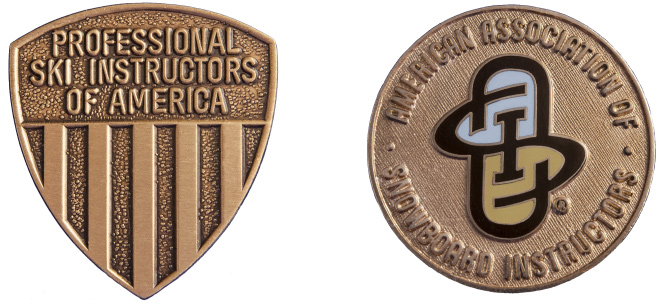This “Last Run” column, written by PSIA-AASI Lead Writer Peter Kray, appears in the Winter 2025 issue of 32 Degrees. You can read the entire issue here.
***
I tend to talk too much. It’s due to a mix of nervous energy, and the desire to tell a story while also contributing to the conversation.
That tendency probably reached its blabber-mouthed height the season I got hired as a snow pro at Jackson Hole Mountain Resort. From the tryout week to the training clinic right up through me getting my first on-hill lesson assignments, I couldn’t wait to share just how much I knew about skiing.
The first hint I might want to blab a little less came when shadowing a senior instructor’s advanced intermediate lesson. Shadowing was a practice the snowsports school used to let new hires like me see how more experienced pros taught. However, I was so full of myself that I thought it was going to be more of a Batman and Robin show, with the two of us co-teaching the class.
It wasn’t until I started offering my own movement analysis of one of the students that the senior instructor, Big Bill Mulligan, gave me a quizzical look and said, “I guess I didn’t expect you to do any talking.”
One week later, Pat Campbell, who was one of my supervisors, made a point of sharing the Apres Vous double chair with me, where she confided, “You could really stand taller. You ski in such a tight crouch it’s harder to make a turn.”
I’d never noticed it, but the next afternoon while skiing Gros Ventre with the sun behind me and my shadow in front me on the snow, I could see what she was saying.
When I finally told Theo “Teddy” Meiners, another senior instructor who would become a hero of mine, that I had tuned my skis that week, and he replied, “I tune mine every night,” I realized how if I talked a lot less, I could learn a lot more about skiing.
SEEK AND YOU SHALL FIND
That’s where the magic began.
The more questions I asked, the more answers I found. Especially about the actual mechanics of the sport. I immediately found one set of instructors who loved to hit the freshly groomed runs right before morning lineup where we would explore the many ways to initiate an edge change – including down-weighting, up and un-weighting, hip thrusts, and stepping onto and steering the uphill ski earlier and earlier in the turn.
Sometimes in the afternoons I found myself trying to hang on to the tails of a steep-minded group who would hit the elevator shaft pitches of the Alta and Expert Chutes using double pole plants to ensure their upper bodies stayed committed to the fall line.
And in the bumps, some of the more worldly lifelong student/instructors of the sport introduced me to the French ski sorcery of avalement. The technique, which has seen its share of print in this magazine, can be as simply put as allowing the knees to flex and absorb the bumps so the skis maintain contact with the mountain.
Then on the lifts back up the hill I would lean into each idea and observation, especially about how I could improve my own skiing.
It was Teddy who told me two things I will never forget. One that my skiing was “too forceful and heavy,” and that I needed “to be lighter and skim across the ridgeline.”
Two, to “never traverse to try and find a better line. Ski what’s in front of you,” he said. “That way, you’ll learn to handle everything.”
IN EVERY RUN, A LESSON
Of course, I was also learning the mountain. Each instructor I followed showed me a different way of seeing and skiing the terrain. The way wind loaded the snow across Rendezvous Bowl off the tram or all the great Thunder Chair treelines.
All of which helped me plan a better day for each of my students, mapping out the runs to match their abilities and desires, while also never skiing too far from a warm lodge and bathroom.
Most importantly, though, was how well I had learned to listen. Each person in a class is constantly giving you new information – especially when they aren’t talking. That’s how I found out that Jeff, the hand surgeon from Virginia, didn’t really like moguls, even though that’s what he booked for a lesson.
However chatty on the chair he was, he went mute at the top of every run. So we found little bump fields he could hit for three or four turns right beside the groomed, and he went home a happy man.
And it wasn’t until Tom and Michi, the retired Dartmouth professors, said they wanted to learn “beautiful skiing” that we hit lap after lap on the perfectly buffed surface of Werner Run, humming The Blue Danube waltz to inform the slow looping pace of each dance down the mountain.
Which is what I’ve really learned – that there is a story in every lesson. A new chapter written with every run. It’s the instructor’s job to help that story come to life by giving each student the opportunity to tell it, turn after turn.

